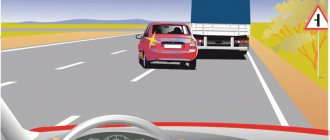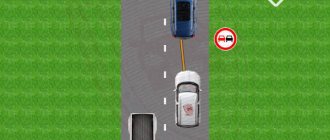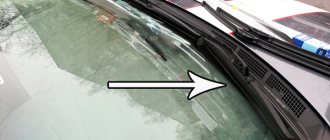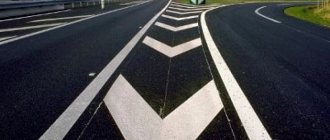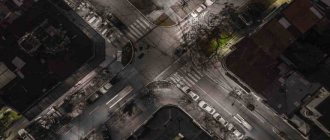What is a dedicated bus lane?
According to the current traffic rules (clause 18.2 of the traffic rules), the bus lane is intended for route vehicles (buses and trolleybuses), as well as passenger taxis.
Attention! If you have any questions, you can chat for free with a lawyer at the bottom of the screen or call Moscow; Saint Petersburg; Free call for all of Russia.
The bus lane is marked with a special sign 5.14. It will be valid until the nearest intersection or until the cancellation sign. In addition, the section of the road along which public transport can move is marked with the letter “A” (it is drawn directly on the road surface).
There are other signs. For example, 5.11 shows that the traffic of route vehicles is organized in the oncoming lane. And signs 5.13.1 and 5.13.2 indicate exit onto such a road.
Who is allowed to enter the lane?
To understand when driving in a dedicated lane is allowed, let's start from the beginning. Let's look at the traffic rules, turn to paragraph 18.2. It states that other vehicles are prohibited from traveling on the public transport road.
However, every rule has an exception. Here is a list of vehicles that move freely along the bus line:
- route transport: buses or trolleybuses;
- school buses;
- taxis and minibuses;
- cyclists.
At the same time, the last three groups can use the bus only if it is not marked with a “brick” sign. If this sign still hangs above the dedicated lane, then only buses are allowed to travel on it. Also, vehicles of this category can only drive along the line with the letter “A” if it is in the same direction as their movement.
When can you use the bus lane?
Only the following may move along the designated section of the bus lane:
- shuttle buses;
- buses heavier than 5 tons, which are included in special lists approved by the executive authorities of Moscow, St. Petersburg or Sevastopol;
- trolleybuses;
- passenger taxis;
- minibuses;
- cyclists.
The driver of other vehicles can only travel here for a short time. For example, if he is leaving the adjacent territory, is going to turn around or disembark passengers. However, all this is provided that the bus lane is separated by a broken line, and the maneuver does not interfere with route vehicles.
Car sharing cars are also not included in the list of vehicles entitled to drive in a dedicated lane (clause 18.2 of the traffic rules). Consequently, the rules for driving in a bus lane in a carsharing vehicle are no different from the duties of a driver of a regular car.
There is a popular misconception that you can drive in a dedicated lane on holidays and weekends. Actually this is not true. And the violator will face full punishment. And on some sections of roads there are automatic fixing devices every 100-200 meters. And out of ignorance, a motorist can accumulate fines of 10-15 thousand rubles for one such “departure”.
In fact, there really are a number of cases when entering the site for route vehicles is not punished in any way (and, on the contrary, is even encouraged). So that the driver can enter the lane on weekends, sign 5.14 (lane for route vehicles) must be accompanied by one of the following symbols.
Sign 8.5.2. It means that entry is prohibited only on weekdays. That is, from Monday to Friday.
Sign 8.5.6. The requirements are similar. But in this case, a specific period of time is indicated during which the ban is valid. That is, from Monday to Friday, from 8:00 to 17:30.
Sign 8.5.3. In this case, the days of the week on which the ban applies are indicated.
Sign 8.5.7. And here only one specific day of the week is marked.
Sign 8.5.5. In this case, the requirements for drivers are similar. There is only one difference: the ban on driving in the bus lane is only valid on weekends.
As you can see, entering the area intended for the movement of route vehicles is only possible if certain signs are present. If they are not there, then driving along such a section is considered a traffic violation. Regardless of the day of the week.
When can other vehicles use the bus lane?
Every driver will have questions regarding lane changes, intersections and stops on the bus line. What to do in a situation when you need to turn right, but the public transport lane is in the way. Or if circumstances force you to stop on this section of the road.
Let's look at both situations.
The bus zone is separated from the main roadway in two ways:
- Continuous stripe marking. In this case, switching to a dedicated line is prohibited.
- Intermittent stripe. You can cross the line and enter the minibus lane.
That is, if turning right is only allowed from the bus line, which is marked with continuous markings, then according to the traffic rules you are not allowed to turn right. This also applies to bicycle holders and taxi drivers if a “no entry” sign is mounted above the road.
Also, modern means of fixation detect even the slightest deviation beyond the solid line. Of course, if there is an obstacle in front of you and a maneuver is required, you will appeal your fine. But it’s better to keep your distance and not go beyond the marking line.
The solution follows from the previous rule. If you cannot cross a solid line, then you are not allowed to stop on a designated road.
However, if the highlighting line is dotted, then you can enter the lane. When crossing intermittent markings, you must make sure that your vehicle will not interfere with the movement of public vehicles. Only in this case, stop within the bus zone. Of course, you should also take into account the area of the “no stopping” or “no parking” signs.
Let us clarify that if the line is still solid, under no circumstances stop in the second lane of the road. This is also prohibited and may cause an accident.
We suggest you read: How to rent an apartment through an agency
If you need to turn right through a bus lane
There is another situation that is no less difficult for most motorists. What should you do if you need to turn right, but the dedicated lane is blocking your passage?
The traffic rules give a complete and detailed answer here too. Thus, paragraph 18.2 of the traffic rules states that a motorist can enter the area for route vehicles when turning right (do not drive along it, but drive out!). However, it should not interfere with public transport. In addition, this is only possible in cases where the lane is separated by intermittent markings. If the markings are solid, drivers are strictly prohibited from changing lanes into the bus lane. Thus, he cannot make a turn at this intersection. And he has no choice but to drive straight to the next intersection.
Conclusion
A separate lane for route vehicles still remains a controversial issue that raises questions. There are no statistics on how much such innovation has improved our lives and relieved traffic, especially automobile traffic. However, the government in any case needs to streamline the situation with roads and cars in big cities, so they use such exotic solutions.
Perhaps this is a reason to switch to public transport, but even buses sometimes get stuck in traffic jams. In cities where there is a metro network, this can save time spent in traffic jams, energy and, most importantly, money.
No matter how you feel about this idea, you should not break the rules and drive in the bus lane, forcing people who cannot afford personal vehicles to wait only for you.
If you need to disembark passengers
The same paragraph 18.2 of the traffic rules states when the driver can change lanes to the bus lane to pick up or unload passengers. The rules here are the same: changing lanes is only possible if the lane is separated by a broken marking line. At the same time, this kind of maneuver should not create interference or interfere with public transport drivers.
If the markings are solid, you cannot change into the bus lane. It will also not be possible to disembark passengers on this section of the road. The fact is that the lane for ordinary cars is the second. That is, stopping here is prohibited.
There is another significant point that many motorists ignore, thereby earning themselves fines. So, if there is no markings on the road at all, but there is a sign 5.14 (bus lane), it is considered that the road is marked with a solid line. That is, it will not be possible to change lanes to board or disembark passengers, much less turn around.
When can you use the bus lane in Moscow?
Most traffic rules apply to the entire country. However, some regional laws may be amended. The situation is especially different in cities of federal significance. In particular, in Moscow.
The difference between Moscow is that here Saturday is equal to working days. And on many sections of the road, instead of sign 8.5.2, sign 8.5.3 is installed here, prohibiting entry into the lane for route vehicles, including on Saturdays. This can only be done on one day of the week – Sunday.
Another important difference concerns the operation of taxis. In addition to the requirements for this group of vehicles, there is one more requirement in Moscow. So, to be considered a taxi, the car must be equipped with a license plate on a yellow background. If it is not there and the driver enters a section of the bus lane, he may be subject to a fine of 3,000 rubles.
When can taxi drivers use a dedicated lane?
The bus lane is also intended for the movement of passenger taxis (clause 18.2 of the traffic rules). However, this car must meet a number of requirements:
- The vehicle must be painted yellow, and so-called “checkered” marks must be applied to the sides.
- There should be a specialized counter in the cabin.
- A special lantern must be installed on the roof.
Only if all of the above conditions are simultaneously met, the driver of the car receives the right to move in a dedicated lane for public transport. In addition, additional requirements apply for Moscow. Namely, the car has license plates on a yellow background.
Thus, private cab drivers who have not properly equipped their vehicles are not allowed to drive in the bus lane. In case of violation, they are assessed a fine from 1,500 to 3,000 rubles.
Driving in a dedicated lane on weekends
The common misconception that traffic in a dedicated lane is allowed on weekends is completely incorrect. However, if there is a sign 8.5.2, you can still drive onto it.
It should be remembered that traffic signs can only allow traffic on the bus section. But they cannot influence the markup in any way. Therefore, if the lane for route vehicles is separated by a solid line, you still cannot cross it. Otherwise the driver will be fined.
Typically, authorities allow travel on a dedicated lane on weekends. However, this permission often does not apply to the Sabbath. In this case, instead of sign 8.5.2, sign 8.5.3 is set.
There is another common situation. After all, weekends and holidays are often postponed. So, if Saturday is declared a working day, then entering the lane marked with sign 8.5.2 is prohibited.
Is it possible to travel on weekends?
The common misconception that traffic in a dedicated lane is allowed on weekends is completely incorrect. However, if there is a sign 8.5.2, you can still drive onto it.
It should be remembered that traffic signs can only allow traffic on the bus section. But they cannot influence the markup in any way. Therefore, if the lane for route vehicles is separated by a solid line, you still cannot cross it. Otherwise the driver will be fined.
Typically, authorities allow travel on a dedicated lane on weekends. However, this permission often does not apply to the Sabbath. In this case, instead of sign 8.5.2, sign 8.5.3 is set.
There is another common situation. After all, weekends and holidays are often postponed. So, if Saturday is declared a working day, then entering the lane marked with sign 8.5.2 is prohibited.
Severe penalties are applied to violators who enter the section of the roadway intended for route vehicles. The latter depends on the severity of the action committed, as well as whether it was committed for the first time.
Thus, according to Article 12.17 of the Code of Administrative Offenses of the Russian Federation, leaving, as well as stopping on a lane allocated for route vehicles, entails a fine of 1,500 rubles. In cities of federal significance (Moscow and St. Petersburg), a fine of 3,000 rubles will be imposed for a similar violation.
However, situations are more dangerous when the driver drives into the oncoming lane for route vehicles. According to Article 12.15 of the Code of Administrative Offenses of the Russian Federation, if the driver drove around an obstacle, he can be fined in the amount of 1,000 to 1,500 rubles. If this happened for other reasons, this amount increases to 5,000 rubles. In some cases, a motorist may be deprived of his driving license for a period of 4 to 6 months.
Starting in 2021, the state allows drivers to pay fines with a 50% discount. However, this requires fulfilling a number of conditions.
First of all, you should make sure that the offense is not included in the list of exceptions of Article 32.2 of the Code of Administrative Offenses, paragraph 1.3 (there is no entry into the bus lane here). In addition, the motorist must pay the fine within 20 days from the date the resolution comes into force (Article 32.2 of the Administrative Code).
Thus, the driver can actually get a discount on the fine for driving in the bus lane. That is, he will have to pay 1,500 rubles in Moscow and St. Petersburg, as well as 750 rubles in other regions of the country. Detailed information can be found directly in the resolution (the date until which the discount is valid will also be noted here). Payment can be made through the official website of the traffic police.
We invite you to read: Refund of personal income tax for treatment: a legally provided opportunity to return money for medical services
If a driver is fined for driving onto a section of the roadway intended for public transport, he is unlikely to be able to appeal this decision. Although there are 3 cases when this is still possible:
- The driver entered the lane due to an emergency, for example, avoiding a collision with an oncoming car.
- The road was not equipped with signs and markings indicating a dedicated lane.
- The driver received 2 fines for the same offense.
The procedure for appealing a traffic police fine for driving in a bus lane is the same as for other violations. In this case, it is enough to write the application correctly and send it.
The appeal instructions look something like this:
- First of all, you need to make sure that the deadline for appeal has not yet expired. The motorist is given 10 days for it (Article 30.3 of the Administrative Code). If time has passed, it will not be possible to send an application. But you can challenge the deadlines (for example, if the driver did not receive a copy of the decision).
- Next, you should decide on the motivation for the appeal (violation due to extreme necessity, lack of composition, etc.).
- After this, it is enough to write an application (an example can be seen here) and send it to the department by mail (the address is indicated in the copy of the resolution). The appeal procedure is determined by Chapter 30 of the Administrative Code.
The traffic police has 10 days from the date of receipt to consider the complaint. If it is sent to court, the latter will consider the case for 2 months (Article 30.5 of the Administrative Code).
How do you know if you can drive in the bus lane today?
To understand which days are considered days off, you need to refer to the Labor Code. Here, namely in Article 112, it is stated that the following days are considered non-working days:
- From January 1 to January 8 – New Year holidays.
- January 7 – Christmas.
- February 23 is Defender of the Fatherland Day.
- March 8 is International Women's Day.
- May 1 – Spring and Labor Festival.
- May 9 – Victory Day.
- June 12 – Russia Day.
- November 4 is National Unity Day.
It should be noted that every year there are two days off during the New Year holidays. They are transferred to other dates. Therefore, a Decree of the Government of the Russian Federation is issued annually, which indicates the numbers considered non-working. For example, in 2021 it is May 2 and 3. And February 23, which fell on Saturday, was postponed to May 10. Thus, working days can become non-working days, and vice versa.
Public holiday dates vary from year to year. To avoid getting a fine, drivers are advised to find information about this in a timely manner.
Responsibility for driving in a dedicated lane
Severe penalties are applied to violators who enter the section of the roadway intended for route vehicles. The latter depends on the severity of the action committed, as well as whether it was committed for the first time.
Thus, according to Article 12.17 of the Code of Administrative Offenses of the Russian Federation, leaving, as well as stopping on a lane allocated for route vehicles, entails a fine of 1,500 rubles. In cities of federal significance (Moscow and St. Petersburg), a fine of 3,000 rubles will be imposed for a similar violation.
However, situations are more dangerous when the driver drives into the oncoming lane for route vehicles. According to Article 12.15 of the Code of Administrative Offenses of the Russian Federation, if the driver drove around an obstacle, he can be fined in the amount of 1,000 to 1,500 rubles. If this happened for other reasons, this amount increases to 5,000 rubles. In some cases, a motorist may be deprived of his driving license for a period of 4 to 6 months. And in a situation where such a violation occurs repeatedly, the driver is deprived of his license for a year (if the passage was recorded by an automatic system, the motorist can get off with a fine of 5,000 rubles).
If the driver entered a lane separated by a solid line, he may receive an additional fine for violating the markings (Article 12.15 of the Administrative Code). Currently it is 1000 rubles.
Is there a discount for driving in a dedicated lane?
Starting in 2021, the state allows drivers to pay fines with a 50% discount. However, this requires fulfilling a number of conditions.
First of all, you should make sure that the offense is not included in the list of exceptions of Article 32.2 of the Code of Administrative Offenses, paragraph 1.3 (there is no entry into the bus lane here). In addition, the motorist must pay the fine within 20 days from the date the resolution comes into force (Article 32.2 of the Administrative Code).
Thus, the driver can actually get a discount on the fine for driving in the bus lane. That is, he will have to pay 1,500 rubles in Moscow and St. Petersburg, as well as 750 rubles in other regions of the country. Detailed information can be found directly in the resolution (the date until which the discount is valid will also be noted here). Payment can be made through the official website of the traffic police.
What is the fine for driving in a bus lane?
Much depends on what kind of offense the driver is charged with. If we are talking specifically about driving or stopping in a bus lane, then according to Article 12.17 of the Administrative Code, a fine of 1,500 rubles
(for Moscow and St. Petersburg this amount is 3,000 rubles).
However, the violation may also be charged as failure to comply with road marking requirements. This happens, for example, when the driver crossed the solid line separating the bus lane from the rest of the roadway, or when he entered it and immediately drove out. In such cases, liability may be limited to a fine of 500 rubles.
, which is provided for in Article 12.16 of the Administrative Code.
Appealing a fine for driving in a dedicated lane
If a driver is fined for driving onto a section of the roadway intended for public transport, he is unlikely to be able to appeal this decision. Although there are 3 cases when this is still possible:
- The driver entered the lane due to an emergency, for example, avoiding a collision with an oncoming car.
- The road was not equipped with signs and markings indicating a dedicated lane.
- The driver received 2 fines for the same offense.
The procedure for appealing a traffic police fine for driving in a bus lane is the same as for other violations. In this case, it is enough to write the application correctly and send it.
The appeal instructions look something like this:
- First of all, you need to make sure that the deadline for appeal has not yet expired. The motorist is given 10 days for it (Article 30.3 of the Administrative Code). If time has passed, it will not be possible to send an application. But you can challenge the deadlines (for example, if the driver did not receive a copy of the decision).
- Next, you should decide on the motivation for the appeal (violation due to extreme necessity, lack of composition, etc.).
- After this, it is enough to write an application (an example can be seen here) and send it to the department by mail (the address is indicated in the copy of the resolution). The appeal procedure is determined by Chapter 30 of the Administrative Code.
The traffic police has 10 days from the date of receipt to consider the complaint. If it is sent to court, the latter will consider the case for 2 months (Article 30.5 of the Administrative Code).
Fines for violations of regulations
If for some reason you drive into a bus lane or cross a solid marking, you will be fined for violating traffic rules. Of course, if you get caught by a security camera or traffic police officers.
Let's take a more specific look at the prices for fines for driving in a dedicated lane.
Departure to the public transport zone of passing traffic:
- in Moscow – 3,000 rubles, regions – 1,500 rubles.
Entering the oncoming road for minibuses:
- 5,000 rubles or withdrawal of driving license for up to 0.5 years, relapse – deprivation of a driver’s license for up to 1 year or 5,000 rubles.
At the same time, you can pay the fine with a 50% discount according to the 2021 resolution. This can be done if you pay the debt within the first 20 days after the fine was received.
In other cases, if you do not agree with the fine, feel free to challenge the punishment. Often, workers make incorrect markings and the public transport lane is located incorrectly. At the same time, it is literally impossible to drive through the area without breaking the rule. There are many examples where authorities actually made mistakes when marking separate transport zones.
Important nuances
The issue of a lane allocated for public transport has several important nuances. Here are the main points that car enthusiasts should pay attention to:
- Often, instead of a bus lane sign, authorities put up a “No Entry” sign (it allows the movement of route vehicles). The fine for violation in this case varies from 500 to 5000 rubles (sometimes deprivation of rights is possible). However, in the case of a dedicated lane, a motorist can receive a fine from 1,500 to 3,000 rubles, depending on the region (Article 12.16 of the Administrative Code).
- Quite often, violations are recorded by automatic systems. This does not affect the punishment in any way (although the driver will definitely not lose his license). However, if there were several devices in a row on one section of the road, each of them can record a violation (there will also be several fines, accordingly).
- The penalty for driving in a bus lane increases significantly if it is in the opposite direction. In extreme cases, the driver may be deprived of his license.
- Sometimes the ban on driving in a dedicated lane applies only to certain days. In this case, a corresponding sign will be installed on the road. However, the presence of such designations does not affect the markings in any way. That is, on certain days, a motorist can move along the bus lane, but he cannot cross a solid line to do this (otherwise the driver may be fined 1,000 rubles in accordance with Article 12.15 of the Code of Administrative Offenses of the Russian Federation).
- If it is necessary to turn right or drop off passengers, the motorist can enter the dedicated lane. However, this can only be done if the lane is separated by a broken marking line.
- It must be remembered that entering a bus lane and crossing a solid marking line are two completely different offenses. Thus, the driver can be fined twice: 1,500 and 1,000 rubles, respectively.
- It is recommended to pay fines immediately after receiving a copy of the decision. This will reduce the amount by 2 times. To receive a discount, the motorist must transfer funds no later than 20 days.
- If there are sufficient grounds, the driver can appeal the punishment.
These were the main features and nuances of driving along a dedicated bus lane. As you can see, there is nothing complicated in the legislation. The main thing is to follow the traffic rules and pay fines on time (although it’s better not to let them appear).
